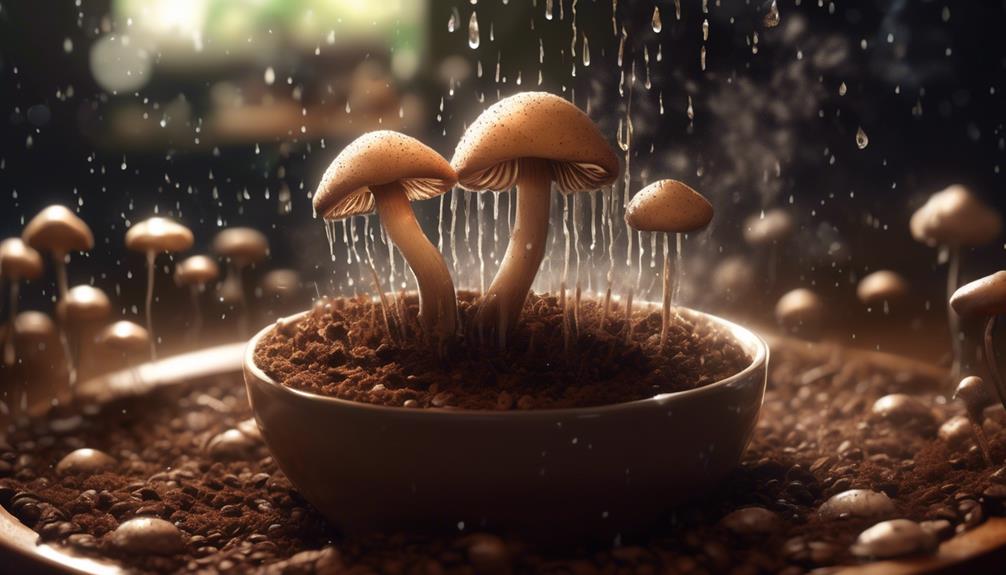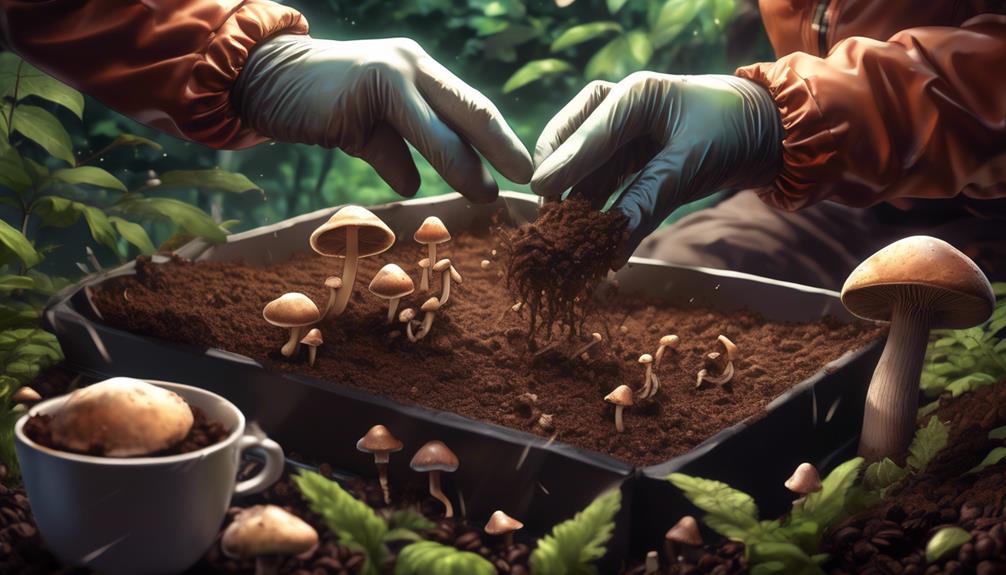How To Become More Self-Sufficient Without Starting a Full-Blown Farm…
Want to start preserving your harvest, making your own soap, or building a backyard root cellar — but not sure where to begin? “Homesteading Advice” gives you instant lifetime access to 35+ practical homesteading books on food preservation, veggie gardening, DIY natural cleaning products (save over $250 per year with this skill alone), brewing, off-grid energy, and a whole lot more…
Click Here To Check It Out Now!
Are you ready to embark on a fascinating journey into the world of mushroom cultivation? Just imagine, your coffee grounds transforming into a thriving ecosystem, where mushrooms flourish and thrive.
But how exactly can you achieve this remarkable feat? Well, my friend, in this article, we will unveil the secrets of growing mushrooms in coffee grounds, revealing the step-by-step process and offering valuable insights along the way.
From the collection and storage of coffee grounds to the careful preparation of the growing container, we will guide you through each stage, ensuring you have all the knowledge necessary to succeed. But that’s not all, we will also explore alternative options and provide essential tips to ensure your mushroom growing endeavor is a safe and rewarding experience.
So, without further ado, let’s unlock the mysteries of growing mushrooms in coffee grounds and unlock the potential of your gardening skills.
Mushrooms & Coffee Grounds
- Coffee grounds can be collected from local stores that sell hot coffee and should be stored in the freezer to prevent mold growth.
- Thawed coffee grounds should be mixed with mushroom spawn and gently compressed in a container to create a growing medium.
- The growing process involves covering the container with perforated plastic, misting the mushrooms twice a day, and removing the cover once the mushrooms start growing.
- It is important to exercise caution when consuming mushrooms, as wild mushrooms can be toxic and some individuals may have allergies or intolerances to mushrooms. Cooking mushrooms before eating is recommended. Mushroom kits can be purchased for convenience and reliability.
Materials and Coffee Ground Collection
To begin growing mushrooms in coffee grounds, gather the necessary materials and collect coffee grounds from local stores that sell hot coffee. Of if you drink enough, use your own ;-0.
For this project, you’ll need a bucket or container, typically a 5-gallon plastic pail, coffee grounds (about half a bucket full), mushroom spore, plastic wrap (optional), and a spray bottle for misting.
It’s important to store coffee grounds in the freezer to prevent mold until you’re ready to use them. Before use, thaw the coffee grounds for 24 hours. Make sure to avoid using moldy coffee grounds for mushroom gardening.
Preparation of Mushroom Growing Container
After gathering the necessary materials and collecting coffee grounds, you can now move on to the preparation of your mushroom growing container.
First you should soak your coffee grounds in boiling water for at least 10 minutes. This helps to sterilize them from any existing fungi or mold spores. Drain in cheese cloth or a sieve and leave to cool down and remove most of the mositure.
When cool fill a 5-gallon plastic pail halfway with coffee grounds.
Next, break up the mushroom spawn and mix it into the coffee grounds. Gently compress the mixture in the bucket and fill it up to within an inch of the top with spore and coffee grounds.
To maintain the moisture level, cover the bucket with clear plastic and perforate it with holes. Mist the mushrooms twice a day with a spray bottle.
‘Did you know? Alternative uses for coffee grounds include composting, adding them to houseplants, or using them as a natural exfoliant for your skin.’
Growing Process and Monitoring

Are you ready to witness the fascinating growth of your mushrooms?
Now that you have prepared your mushroom growing container, it’s time to dive into the growing process and monitoring techniques.
Incubation:
- Place the filled container in a warm and dark environment, preferably between 65-75°F (18-24°C).
- Maintain high humidity levels, around 80-90%, to create an optimal environment for mycelium growth.
- Regularly mist the substrate to maintain moisture levels.
Pinning and Fruiting:
- After a few weeks, you’ll notice white web-like structures called mycelium spreading throughout the substrate.
- When the mycelium has fully colonized the substrate, small pin-like structures called pins will start to form.
- Maintain optimal conditions for fruiting, including temperature, humidity, and light exposure, according to the specific mushroom species you are growing.
- Mist the pins and maintain humidity levels to avoid drying out.
Monitoring Techniques:
- Regularly check the moisture levels of the substrate and mist if necessary. Moisture is crucial for proper mushroom growth.
- Monitor temperature and ensure it remains within the recommended range for your mushroom species.
- Keep an eye on the appearance of the pins, their size, and color. This can indicate the health and progress of your mushrooms.
- Check for any signs of contamination like mold or unpleasant odors. If detected, take immediate action to prevent further damage.
- Document the growth progress through photos or notes, which can help you analyze and improve future cultivation endeavors.
Remember, different mushroom species have specific requirements, so it’s important to research and tailor your techniques accordingly.
To help you keep track of your mushrooms’ progress, here is a table outlining common mushroom growing problems and troubleshooting tips:
| Problem | Possible Cause | Solution |
|---|---|---|
| Slow growth | Low temperature or humidity | Increase temperature and humidity levels |
| Mold growth | Excessive moisture or contamination | Reduce moisture levels and ensure cleanliness |
| Small, deformed mushrooms | Lack of air circulation or inadequate light | Improve air circulation and provide more light |
| Mushroom caps turning black | Overmaturity or excessive handling | Harvest mushrooms when caps are fully open |
| Mushrooms not fruiting | Insufficient nutrients or incorrect pH level | Adjust nutrient levels and pH balance |
“Did you know? Mushrooms are not plants or animals, but actually belong to their own kingdom called Fungi. They have a unique and fascinating ability to break down organic matter and recycle nutrients back into the ecosystem.”
Additional Mushroom Growing Options
For those who prefer a more convenient and reliable option, mushroom kits can be purchased from reputable sources like Amazon or found at Whole Food Markets.
These kits provide an alternative to the coffee ground method of growing mushrooms. With mushroom kits, you can skip the process of collecting and preparing coffee grounds and simply follow the instructions provided.
Mushroom kits typically come with pre-inoculated substrate and detailed instructions, making it easier for beginners to grow their own mushrooms.
Additionally, purchasing mushroom kits ensures that you’re using high-quality spores from trusted sources. This eliminates the need to find alternative sources for mushroom spores, which can be challenging for those new to mushroom cultivation.
So, if you prefer a more hassle-free approach, mushroom kits are worth considering.
Final Thoughts…

To ensure successful mushroom cultivation, it’s important to keep in mind some general tips and warnings. Here are some key points to remember:
- Collect coffee grounds from stores that sell hot coffee on a daily basis. Freezing the grounds prevents mold growth, but remember to thaw them before use. Avoid using coffee grounds that are moldy.
- For convenience and reliability, consider purchasing mushroom kits from reputable sources like Back to the Roots. These kits provide all the necessary materials and instructions for successful mushroom cultivation.
- Never pick wild mushrooms for consumption as they may be toxic. It’s recommended to cook mushrooms before eating them. Additionally, some individuals may have allergies or intolerances to mushrooms.
So, why wait? Dive into the world of growing mushrooms in coffee grounds and watch as your garden comes to life with these nutrient-rich wonders. With just a few simple steps, you can recycle waste, create a thriving environment, and embark on a new and exciting gardening project.
